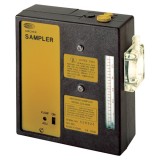
• Protect sample pump from weather when in use outdoors.
• Powering the pump with any device other than the approved battery pack voids the UL Listing for intrinsic
safety.
• Do not use the pump with the Battery Eliminator in hazardous locations. UL Listing for intrinsic safety is not in
effect during pump operation with Battery Eliminator.
• Use of any device other than the approved battery pack or Battery Eliminator to power the pump voids any
warranty.
• Charge pump battery completely before calibration and sampling.
1. Replace the sampling medium used for calibration with an unexposed medium for sample collection.
2. Place the sampling medium where appropriate for sampling.
a. For personal sampling, clip the sampling medium to the worker in the breathing zone.
b. When using impingers, an in-line trap (SKC Cat. No. 225-22 or 225-22-01) is required to prevent
fumes from accidentally being drawn into the sampler. Place the in-line trap between the pump
and the impinger. Mount the impinger and trap to the face of the sampler using the accessory
mounting screws (Figure 1) or place them in a holster at the worker’s waist.
Failure to use an appropriate in-line trap during impinger sampling voids any warranty.
c. When using the pump for pressure applications, such as bag sampling, thread the exhaust port
fitt ing supplied with the pump into the air discharge port on top of the pump; hand-tighten only.
Using PTFE tubing, connect the inlet of the sample medium (e.g., sample bag) to the exhaust port
fitt ing on the pump. Turn on the pump to collect the appropriate volume of air. Shut off the pump
and close inlet on sample medium to stop sampling.
3. Start sampling by turning on the pump using the on/off switch (Figure 1). Record the start time.
4. At the end of the sampling period, turn off the pump and record the stop time.
5. Seal the sample and send it with blanks and pertinent sampling information to a laboratory for analysis.
6. Verify the fl ow.
a. Turn on the pump and reinstate the calibration train and sampling media.
b. Take three readings and record the average value as the post-sample fl ow rate. Do not adjust the pump fl ow rate during this step.
c. Compare the pre and post-sample fl ow rates. Note in sampling documentation if the values diff er by more than ± 5%